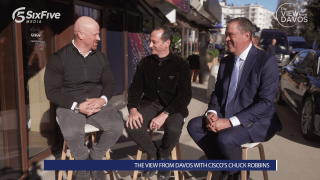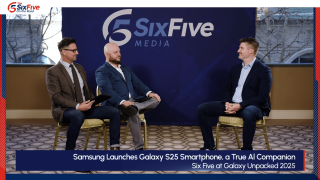The Six Five team discusses Vast Data COSMOS
If you are interested in watching the full episode you can check it out here.
Disclaimer: The Six Five Webcast is for information and entertainment purposes only. Over the course of this webcast, we may talk about companies that are publicly traded and we may even reference that fact and their equity share price, but please do not take anything that we say as a recommendation about what you should do with your investment dollars. We are not investment advisors and we ask that you do not treat us as such.
Transcript:
Daniel Newman: Let’s go ahead and talk first about VAST Data. Company is on fire, over $9 billion valuation. They had a big launch, a big event called COSMOS this week. What was going on there?
Patrick Moorhead: Yeah, so every four or five years, a hot storage company comes along and really resets everything, right? I think NetApp falls into that category even though they’re a lot older, but they redefined a lot of things like Filer as an example. And then you had Pure Storage that came out with a bladed architecture really focused on software first and the ability to create a chassis that you could plug into, but most of the magic was about the software. And then you have VAST Data who entered the scene. And if you can imagine the different stacks from storage to file systems to database, their effort was to collapse that stack. And by the way, they don’t sell storage. They are a software company. A very disruptive company out there.
And what they did is they came out at their COSMOS event. The biggest announcement was called Insight Engine. And this is in collaboration with NVIDIA. And there was a nice interview between Jensen and VAST Data CEO, Renen Hallak. And it was pretty good. And what it’s about is real time data operating system for AI. That’s the tagline. I think it’s fair. It’s one of the operating systems that you’ll be dealing with. But what it does, and this integrates with all the NIMs microservices, is it embeds the semantic data. Semantic meaning, into the data, right? And current process, again, there are people more technical than I, like Matt on my team, you’ve got a lot of great analysts that I’m sure we will dig deeper, but essentially typically FDTL this data off into a database. And it’s a two-step process to create all the factors, right? What they’ve done is they’ve collapsed. So essentially it includes a vector database, so it’s one step versus two.
And the cool part about the security side is it keeps all the security embeddings that are attached the data as opposed to ETLing that out and having to reapply some security policies. This is focused on the enterprise, not the hyperscalers. Although, VAST Data is very tied into hyperscalers like xAI and Grok, a platform that we spend way too much time on and they are likely part of this as well. The other announcements, Cisco and Equinix, Cisco’s integrating into UCS, they’re integrating the entire VAST Data stack. We don’t hear a lot about use Cisco, UCS, it’s not the number one priority at Cisco. It’s software or services and networking, but they very much are a major factor into blades for enterprises. There’s also a deal with Equinix. The stack’s going to be integrated into Equinix data centers for their clients.
And finally this was more of a community initiative. It’s called COSMOS, right? A lot of people came out, practitioners, researchers, tech vendors came out. And if you follow the storage market, every company has a, I’ll call it vast following of this. We’re going to have to see what does this mean competitively. We don’t know yet. It’s very provocative and we haven’t heard anything from Dell. We really haven’t heard anything from Pure. You attended the NetApp event out there and again, it’s different but it appears that they, they’re trying to accomplish the same thing, but we’re going to have to see.
Daniel Newman: Yeah, there is a lot going on, Pat, it feels a little bit like I’m going to be repeating some of what I said after NetApp. There seems to be a new paradigm that is going to be taking place in the storage industry. Now what’s fun about this is none of them want to call themselves storage anymore, which is understandable because the capacity and capabilities that these companies have is becoming much more prolific in terms of how these companies can be utilized in the AI computer. So you had the historic of right storage being multi-tier, lots of data that’s relatively inaccessible in real time from compute memory. Now, we are entering an era where we want to effectively make all data available at any time and in compute in order to process, inference, train, whatever you’re trying to do. And to your point, NetApp, Pure, all these companies are working on creating a compute and storage alignment where there’s less of this sort of what I call middle layers, by reducing the need for certain softwares by making files and data of all types instantly accessible by compute.
So basically, point the application at the Vast system as opposed to the Insight Engine, as opposed to needing to point it at some sort of data lake, right? This is where it’s all heading. Where it can then understand is it object, is it file, is it vector? What kind of data is it? How is it that data being, Meta. What kind of metadata is available to that data? And then allowing an application to instantly access that for say, inference. That’s where we’re heading. All these companies are on the same trajectory in trying to do this. Vast went to an over $9 billion valuation by really beating this drum for a few years and they were beating this drum by the way, well before Gen AI was really a thing. They’ve been saying for a long time that we need to de-complexify, if that’s even a word, the whole way storage is architected and the way data is made available.
And of course, we know with RAG and generative AI that vector that the ability to treat many different types of data consistently and making it very accessible without needing to all be always organized, constantly updating databases. That’s the holy grail, that’s the holy grail of where we’re trying to head. So that’s what’s going on. To me, companies made the right alignment, it’s gotten the right partners, it’s in with xAI, it’s in with NVIDIA. Clearly they understand where they want to be connected, where they want to be aligned to. And of course, from a rare on-stage appearance.
Patrick Moorhead: That’s good man.
Daniel Newman: Be a CEO Jensen Huang only further reiterated, but it was a solid event. The momentum continues. Of course, seeing these things shipping and in the real world and of course, seeing companies large, companies doing big AI work, being able to basically say that they have effectively maybe moved on from certain needs for different hardware software that were typical abstractions in this whole data pipeline could get really interesting. So, definitely a watch list company, Pat, and I got to imagine an IPO is coming, I just have to imagine.






















































































